Production Year 2000
 Maestros de alta tecnología | Dedos hábiles para la moda
Maestros de alta tecnología | Dedos hábiles para la moda
DC790009![]()
ハイテクの職人たち | 最新ファッションを生む指先の技 [NHK]
![]()
![]()

|Length : 10min. |Year : 2000 |
El 50% de las fibras fabricadas en el mundo son productos químicos obtenidos a partir de materias primas derivadas del petróleo que se hacen pasar a presión por diversas boquillas. Las fibras químicas japonesas son apreciadas en todo el mundo por su excelente calidad. La forma de cada fibra determina sus propiedades específicas y cada fabricante realiza investigaciones constantes para crea nuevas fibras que le permitan obtener ventajas competitivas en la industria.
El quid de al calidad y de las propiedades de las fibras químicas es la precisión de los minúsculos orificios –algunos de apenas 100 micrones de diámetro- que deben perforarse en las boquillas usadas en el proceso de fabricación. Estos orificios se hacen con herramientas hechas a mano. Este documental tiene como personaje central al Sr. Akinori Katayama que fabrica tales herramientas para el mayor proveedor de fibras químicas del mundo.
El Sr. Katayama , que en su juventud quiso ser boxeador, fue honrado recientemente con el título de "maestro artesano contemporáneo" por el Ministerio del Trabajo de Japón, en reconocimiento de su contribución a la adaptación de las técnicas tradicionales a las industrias de alta tecnología de la actualidad. A diario, el Sr. Katayama lima y pule extraordinarias herramientas del espesor de n cabello humano hechas de aleaciones ultra duras, guiado únicamente por la sensación que es capaz de percibir en la yema de sus dedos. El Sr. Katayama no pudo convertirse en un campeón del cuadrilátero en su juventud, pero hoy, 30 años después, es un campeón en el mundo oculto de la fabricación de fibras químicas.
 Digital Pictorial Book - Nature in Japan - | Digital Pictorial Book – Nature in Japan –
Digital Pictorial Book - Nature in Japan - | Digital Pictorial Book – Nature in Japan –
ED090000![]()
デジタル大図鑑 ~日本の自然~ [NHK]
![]()
![]()
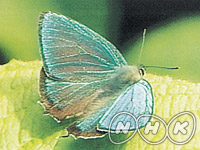
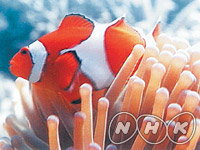
|Length : 15min. x26 |Year : 2000 |
This 26-part series is a collection of images of some of the animals inhabiting the Japanese archipelago. Each episode is packed with rare insights into the lives of Japan's animals, fish, birds and insects.
[1. Animal Courtship]
1. The Jump of the Mudskipper
2. The Courtship of the Ruddy Kingfisher
3. The Courtship of the White-Cheeked Flying Squirrel
4. The Dance of the Short-Tailed Albatross
5. The Courtship of the Hakusen Fiddler Crab
[2. Animals in Winter]
1. The Japanese Sable Plays Tag
2. The Varied Tit Prepares for Winter
3. Habitats of the Flying Squirrel
4. The Iriomote Glow-Worm Glows in Winter
5. The Japanese Macaque Searches for Food
[3. Autumn Migrants]
1. The Visit of the White-Naped Crane
2. The Visit of the White-Fronted Goose
3. The Visit of the Black-Faced Spoonbill
4. The Grey-Faced Buzzard Heads South
5. The Life-and-Death Flight of the Brown-Eared Bulbul
[4. Building Nests]
1. The Nest of the Harvest Mouse
2. The Carpenter Bee's Nest
3. Great Black Woodpecker Parents
4. The Badger's Set
5. The Nest of the Long-Tailed Tit
[5. Courting in Spring]
1. The Songs of the Bush Warbler
2. The Radiant Colours of the Male Pheasant
3. The Courtship of the Giant Water Strider
4. The Courtship Feeding of the Little Tern
5. The Great Imitators: Bull-Headed Shrikes
[6. Creatures of the Southern Islands]
1. Sperm Whales Dive Deep
2. The Behaviour of Bonin Flying Foxes
3. A Native Species: Bonin Islands Honey-Eaters
4. Feral Goats
5. A Green Turtle Lays Her Eggs
[7. Fish Spawning and Hatching]
1. The Birth of the Medaka
2. The Birth of the Two-Banded Anemone Fish
3. The Birth of the Biwa Catfish
4. The Birth of the Blue-spotted Mudskipper
5. The Birth of the Chum Salmon
[8. Laying Eggs and Rearing Chicks]
1. Swallows: Parenting under the Eaves
2. Brown Dippers: Parenting by a Mountain Stream
3. Peregrine Falcons: Parenting on a Cliff
4. A Colony of Grey Herons
5. Rock Ptarmigans: Parenting in High Mountains
[9. Forest Dwellers]
1. Japanese Macaques on Yakushima Island
2. From Forest to Sea: Red-Legged Crabs
3. Grey-Faced Buzzards of the Satoyama
4. Jewels of the Forest: Green Mountain Butterflies
5. Black Woodpeckers in the Virgin Forest
[10. Hunters]
1. The Trapdoor Spider's Ambush
2. The Greater Pied Kingfisher's Dive
3. Giant Water Bugs: Hunting with Forelegs
4. The Four-Spined Sculpin's Stone Camouflage
5. The Powerful Suckers of the Common Octopus
[11. Life Among the Ice Floes]
1. Above the Ice Floes: White-Tailed Sea Eagles
2. Drifting Ice Angels
3. Mother and Baby: Saddle-Backed Seals
4. Scallops on the Seabed
5. Fish Beneath the Ice Floes
[12. Survival Strategies]
1. Masters of Disguise: Octopuses
2. Leaf or Butterfly? Leaf Butterflies
3. Seaweed Camouflage: Tiarinia cornigera
4. Fish Lures: Green-Backed Herons
5. A Multicoloured Coat: Flashback Cuttlefish
[13. Winter Migrants]
1. The Short-Eared Owl: A Hunter
2. Sandpipers on the Tidal Flats
3. The Courting Behaviour of Wild Ducks
4. Japanese Waxwings and Mistletoe
5. The Feeding Grounds of the Black-Headed Gull
[14. The Wonder of Seeds!]
1. White Birch Seeds Fly on the Wind
2. The Seed-Packed Spike of the Cattail
3. The Popping Seeds of the Wood Sorrel
4. Themeda japonica's Rotating Seeds
5. Birds Love Linden Viburnum Berries
[15. Hunting Techniques]
1. The Ambush of the Stonefish
2. Cone Shells Shoot Their Poison Darts
3. Feeding Techniques of the Spotted Eagle Ray
4. The Feeding Habits of Shorebirds
5. The Agility of the Trapdoor Spider
[16. Seashore Breeders]
1. Grass Puffers Come Ashore to Spawn
2. The Life Cycle of the Spear Squid
3. The Colourful Eggs of the Sailfin Sandfish
4. The Spawnings of the Hermaphroditic Sea Hare
5. The Mysterious Glow of the Firefly Squid
[17. Creatures of the Coral Reef]
1. A Day on a Coral Reef
2. Crown-of-Thorns Starfish: Coral's Natural Predator
3. Defensive Strategies of the Parrot Fish
4. How Damselfish Protect Their Eggs
5. Cleaner Wrasses: The Cleanerrs of the Coral Reef
[18. Creatures of Clear Streams]
1. Japanese Chars: Headwater Dwellers
2. Common Kingfishers: The Jewels of Clear Streams
3. Ayu: Growing Up in the River
4. Survival Strategies of Caddisflies
5. The Spawning of Brown Stream Frogs
[19. Mangroves]
1. Mangroves: The Cradle of life
2. Rhizophora stylosa: A Paradise for Fish
3. The Aerial Roots of Sonneratia alba
4. The Survival Strategy of Avicennia marina
5. Bruguiera gymnorrhiza: Thickets Teeming with Life
[20. Colony Breeders]
1. The Parenting of the Black-Crowned Night Heron
2. The Slaty-Backed Gull of Daikoku-jima, Hokkaido
3. Common Cormorants in the City
4. The Nocturnal Life of Leach's Storm Petrels
5. A Spectacular Colony of Common Guillemotsd
[21. Creatures of the Mangroves]
1. Soldier Crabs on a Sandy Beach
2. Barred Mudskippers on the Tidal Flats
3. Fish in the Mangrove
4. A Leaf-Eating Mangrove Crab
5. The Mud Lobster Builds a Nestd
[22. Creatures of the Wetlands]
1. Red-crowned Cranes in the Kushiro Marsh
2. Siberian Salamanders
3. Redshanks on the Notsuke Peninsula
4. Water Spiders
5. Red-necked Grebesd
[23. Symbiosis: Helping Each Other]
1. Coral and Coral Crabs
2. Gobies and Snapping Shrimps
3. Sea Anemoes and Anemonefish
4. Ants and Aphids
5. The Coral's Secret
[24. Animals That Use Man-Made Objects]
1. Dusky Tripletooth Gobies: Parenting in an Empty Can
2. Oriental Particoloured Bats: A Nursery in the Attic
3. Magpies: Nests atop Power Poles
4. Land Hermit Crabs: House-Hunting Experts
5. Swallows: Parenting under the Eavest
[25. Strategies for Species Preservation]
1. Perch Sculpin and Their Sea Squirt Cradle
2. How Shirozua jonasi Cheats Ants
3. The Explosive Breeding Power of Aphids
4. Coypus: Dwelling on the Water's Edge
5. How Kobi Cuttlefish Use Sponges
[26. Child-Rearing Fathers]
1. Male Painted Snipes: The Plainer Sex
2. Japanese Freshwater Perch: Guarding the Young
3. The Male Seahorse's Brood Pouch
4. Giant Water Bugs Carry Eggs on Their Backs
5. The Three-Spined Stickleback Builds a Nest
 Experiments Are Fun | Experiments Are Fun
Experiments Are Fun | Experiments Are Fun
ED100000![]()
やってみようなんでも実験 [NHK]
![]()
![]()
![]()
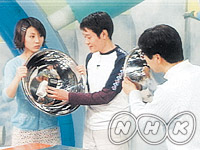

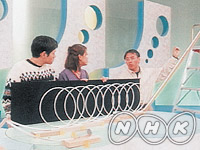
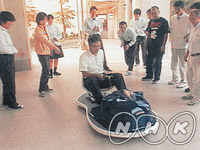
|Length : 25min. x26 |Year : 2000 |
This series aims to encourage young people to find things out for themselves in the spirit of 'giving it a try', and to show that so many experiments can be fun.
Every program features watch-and-see experiments unique to that episode's Master of Experiments, as well as experiments that will encourage everyone to have a try. In these experiments we use everyday items to delve into science.
Experiments often involve failure. Not even the Masters of Experiments are exceptions to this. In the programs, we show their experiments in full even if they do not entirely succeed, because we think it more important to nurture the process of experiment than it is to get the "right" result.
1. Let's Build a Gigantic Electrostatic Generator!
2. Let's Try to Create a Huge Rainbow
3. Recreating the Pterosaur, a Prehistoric Glider
4. Moulding Aluminium into a Bell
5. Speedy Hydrofoils, I Can Make One Myself!
6. Feel the Effects of Solar Power!
7. A Hose and the Speed of Sound
8. Let's Make an Air-Engine!
9. Spin and Rise: Making Amazing Kites!
10. Let's Measure the Earth's Weight
11. Strength Guaranteed: Building with Paper
12. The Science of Air Cannons
13. The Amazing Art Created by Vibrations
14. Antennas of All Shapes and Sizes
15. Up and Away, Rubber-band-driven Helicopters!
16. Say Cheese! Super-panoramic Photos with Pin-hole Cameras
17. Wondrous Colors: The Science of Polarisation
18. Power of Waterwheels!
19. Heat Generates Music? "The Whistling Pot Challenge"
20. Let's Build a Clockwork Doll: A Robot from the Edo Period
21. Zero Friction Challenge: Hovercraft, Float and Run!
22. The First Magnetic Recording: Let's Make a Wire Recorder
23. Vibration Makes Scrub Brush Car Go
24. Gravity Powers a Roller Coaster
25. Harnessing the Unusual Power of Static Electricity
26. Making Musical Instruments from Everyday
 El Reino de las Matemáticas | El Reino de las Matemáticas
El Reino de las Matemáticas | El Reino de las Matemáticas
ED580000![]()
ワンダー数学ランド [NHK]
![]()
![]()
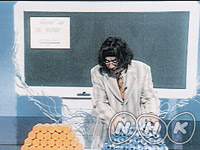

|Length : 25min. x7 |Year : 2000 |
Cuando usted escucha la palabra "matemáticas", quizás imagina que esta ciencia sólo tiene que ver con cálculos tediosos y solución de ecuaciones. En "El Reino de las Matemáticas", usted descubrirá por sí mismo la lógica detrás de las fórmulas
matemáticas, con la ayuda de soportes visuales. Se proponen barios experimentos, y se la invita a encontrar el resultado. Luego puede verificar si su respuesta es la correcta, siguiendo el desarrollo lógico del problema en la pantalla. El enfoque de esta serie no está limitado por los métodos convencionales de los libros de texto. En esta serie, el Profesor Jin Akiyama, matemático japonés, demuestra en el estudio teoremas y fórmulas matemáticas, con la ayuda de diversos instrumentos y modelos que los alumnos encontrarán muy interesantes.
1. La manera inteligente de contar - La suma de números enteros -
2. Usa tus neuronas para medir - Volumen de la pirámide y el prisma -
3. El fantástico Pitágoras - Aplicaciones del teorema de los 3 cuadrados -
4. ¿FRENTE? ¿REVES? ¿Y LUEGO QUÉ VES? - Las características de una superficie curva -
5. El balance lo es todo - Centro de gravedad -
6. Giros deslumbrantes - Círculos inscritos -
7. Hagamos un hoyo cuadrado - Las propiedades de ciertas formas -
- 1
- 2














